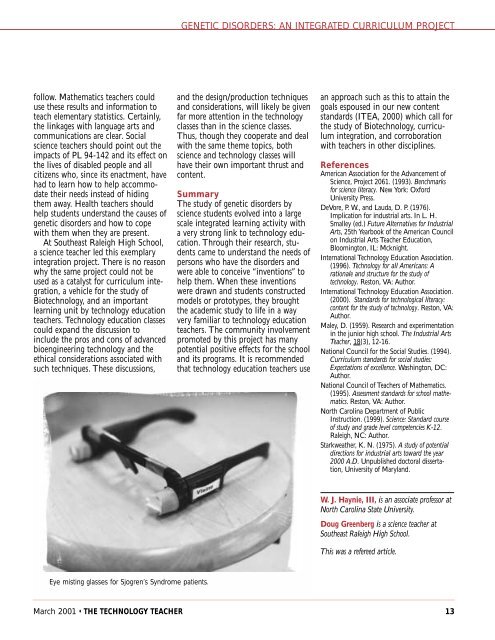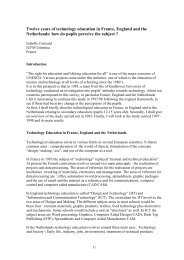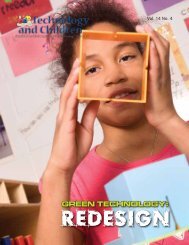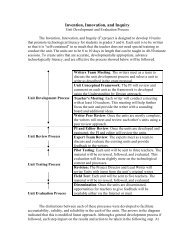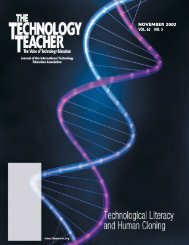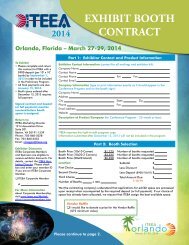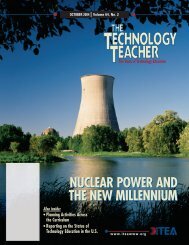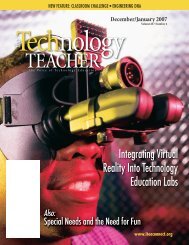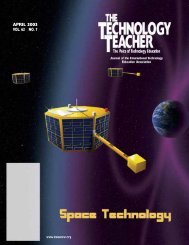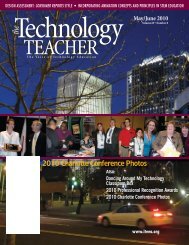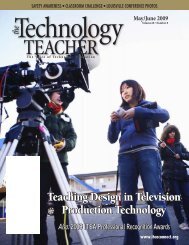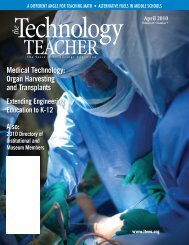MARCH 2001 VOL. 60 NO. 6 - International Technology and ...
MARCH 2001 VOL. 60 NO. 6 - International Technology and ...
MARCH 2001 VOL. 60 NO. 6 - International Technology and ...
Create successful ePaper yourself
Turn your PDF publications into a flip-book with our unique Google optimized e-Paper software.
follow. Mathematics teachers could<br />
use these results <strong>and</strong> information to<br />
teach elementary statistics. Certainly,<br />
the linkages with language arts <strong>and</strong><br />
communications are clear. Social<br />
science teachers should point out the<br />
impacts of PL 94-142 <strong>and</strong> its effect on<br />
the lives of disabled people <strong>and</strong> all<br />
citizens who, since its enactment, have<br />
had to learn how to help accommodate<br />
their needs instead of hiding<br />
them away. Health teachers should<br />
help students underst<strong>and</strong> the causes of<br />
genetic disorders <strong>and</strong> how to cope<br />
with them when they are present.<br />
At Southeast Raleigh High School,<br />
a science teacher led this exemplary<br />
integration project. There is no reason<br />
why the same project could not be<br />
used as a catalyst for curriculum integration,<br />
a vehicle for the study of<br />
Biotechnology, <strong>and</strong> an important<br />
learning unit by technology education<br />
teachers. <strong>Technology</strong> education classes<br />
could exp<strong>and</strong> the discussion to<br />
include the pros <strong>and</strong> cons of advanced<br />
bioengineering technology <strong>and</strong> the<br />
ethical considerations associated with<br />
such techniques. These discussions,<br />
Eye misting glasses for Sjogren’s Syndrome patients.<br />
March <strong>2001</strong> • THE TECH<strong>NO</strong>LOGY TEACHER<br />
GENETIC DISORDERS: AN INTEGRATED CURRICULUM PROJECT<br />
<strong>and</strong> the design/production techniques<br />
<strong>and</strong> considerations, will likely be given<br />
far more attention in the technology<br />
classes than in the science classes.<br />
Thus, though they cooperate <strong>and</strong> deal<br />
with the same theme topics, both<br />
science <strong>and</strong> technology classes will<br />
have their own important thrust <strong>and</strong><br />
content.<br />
Summary<br />
The study of genetic disorders by<br />
science students evolved into a large<br />
scale integrated learning activity with<br />
a very strong link to technology education.<br />
Through their research, students<br />
came to underst<strong>and</strong> the needs of<br />
persons who have the disorders <strong>and</strong><br />
were able to conceive “inventions” to<br />
help them. When these inventions<br />
were drawn <strong>and</strong> students constructed<br />
models or prototypes, they brought<br />
the academic study to life in a way<br />
very familiar to technology education<br />
teachers. The community involvement<br />
promoted by this project has many<br />
potential positive effects for the school<br />
<strong>and</strong> its programs. It is recommended<br />
that technology education teachers use<br />
an approach such as this to attain the<br />
goals espoused in our new content<br />
st<strong>and</strong>ards (ITEA, 2000) which call for<br />
the study of Biotechnology, curriculum<br />
integration, <strong>and</strong> corroboration<br />
with teachers in other disciplines.<br />
References<br />
American Association for the Advancement of<br />
Science, Project 2061. (1993). Benchmarks<br />
for science literacy. New York: Oxford<br />
University Press.<br />
DeVore, P. W., <strong>and</strong> Lauda, D. P. (1976).<br />
Implication for industrial arts. In L. H.<br />
Smalley (ed.) Future Alternatives for Industrial<br />
Arts, 25th Yearbook of the American Council<br />
on Industrial Arts Teacher Education,<br />
Bloomington, IL: Mcknight.<br />
<strong>International</strong> <strong>Technology</strong> Education Association.<br />
(1996). <strong>Technology</strong> for all Americans: A<br />
rationale <strong>and</strong> structure for the study of<br />
technology. Reston, VA: Author.<br />
<strong>International</strong> <strong>Technology</strong> Education Association.<br />
(2000). St<strong>and</strong>ards for technological literacy:<br />
content for the study of technology. Reston, VA:<br />
Author.<br />
Maley, D. (1959). Research <strong>and</strong> experimentation<br />
in the junior high school. The Industrial Arts<br />
Teacher, 18(3), 12-16.<br />
National Council for the Social Studies. (1994).<br />
Curriculum st<strong>and</strong>ards for social studies:<br />
Expectations of excellence. Washington, DC:<br />
Author.<br />
National Council of Teachers of Mathematics.<br />
(1995). Assessment st<strong>and</strong>ards for school mathematics.<br />
Reston, VA: Author.<br />
North Carolina Department of Public<br />
Instruction. (1999). Science: St<strong>and</strong>ard course<br />
of study <strong>and</strong> grade level competencies K-12.<br />
Raleigh, NC: Author.<br />
Starkweather, K. N. (1975). A study of potential<br />
directions for industrial arts toward the year<br />
2000 A.D. Unpublished doctoral dissertation,<br />
University of Maryl<strong>and</strong>.<br />
W. J. Haynie, III, is an associate professor at<br />
North Carolina State University.<br />
Doug Greenberg is a science teacher at<br />
Southeast Raleigh High School.<br />
This was a refereed article.<br />
13


